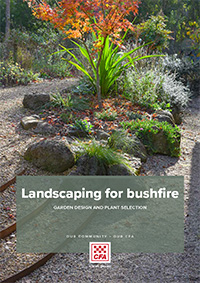The location, type and ongoing maintenance of vegetation within a property can significantly reduce the impact of a bushfire on any house.
Landscaping for bushfire is much the same as any type of gardening. It involves planning, designing, planting and managing the area around your house. Design and plant selection for bushfire can help reduce the effects of direct flame contact and radiant heat on a house.
 Landscaping for Bushfire: Garden Design and Plant Selection provides information on garden design and plant selection which can be used for new or existing gardens in high-risk bushfire areas.
Landscaping for Bushfire: Garden Design and Plant Selection provides information on garden design and plant selection which can be used for new or existing gardens in high-risk bushfire areas.
- Use the online Plant Selection Key to help choose plants for a garden in a high bushfire risk area
Garden Design
When modifying an existing garden or designing a new one, you need to consider the placement of garden beds, trees and other flammable objects.
You should aim to keep the area around your house and other structures (such as carports and sheds) free of plants that can easily catch fire and then ignite the buildings. You should also separate the flammable elements from each other and the house itself.
Garden design should incorporate the following four principles:
- Create defendable space
- Remove flammable objects from around the house
- Break up fuel continuity (keep plants separate)
- Carefully select, locate and maintain trees.
Choosing suitable plants
Although all plants will burn under the right conditions, some plants are less likely to catch fire than others. Choosing plants with low flammability and locating them correctly will help reduce bushfire risk within a garden.
Make a list of the plants you want to use in your garden and work through the questions in the Key to find out the flammability rating of each plant.
Remember: While a well-planned garden is important, it is only one aspect of preparing for bushfire. A holistic approach to bushfire preparation is critical. Appropriate water supply, access, house construction and general property maintenance are all important. On Extreme and Catastrophic days, leaving early is the safest option to protect yourself and your family.
Example gardens
The following gardens provide practical examples of landscaping for bushfire in four risk environments:
Read a case study (PDF 6.7MB) about a family in the Victorian Goldfields who used landscaping for bushfire design principles when they built their new home.
Page last updated: Wednesday, 21 December 2022 2:45:31 PM